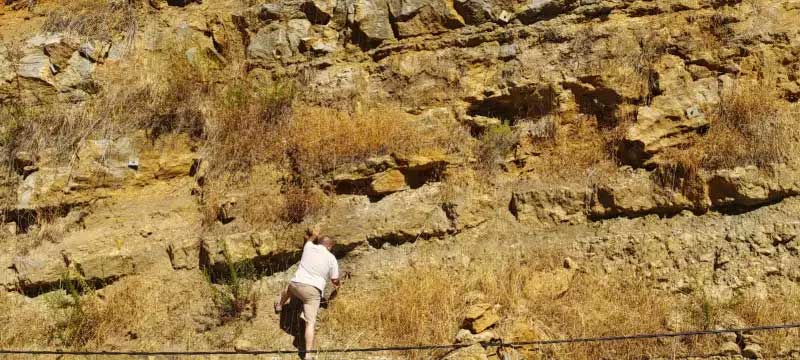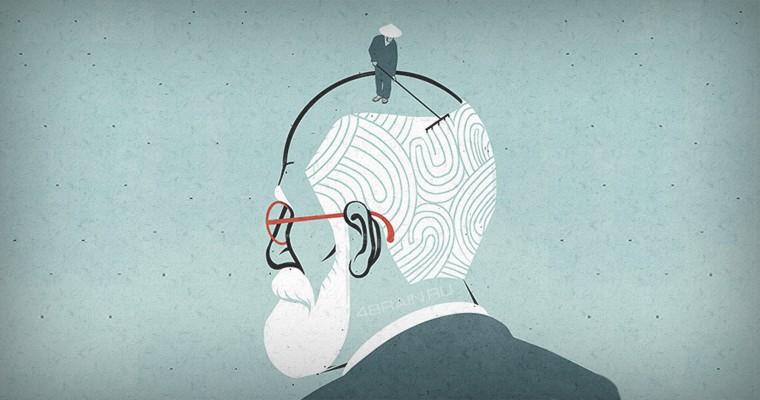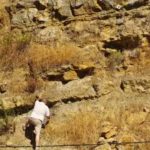Architecture
Woven City is a smart city built by Toyota based on hydrogen energy technology
History
The Gunung Padang archaeological site in western Java was built by a civilization 25,000 years ago
Philosophy
$1 million to anyone who solves one of the 7 hardest math problems in the world – The Riemann Hypothesis
Music
Five Revolutions in Modern Music
Religion
Tibetan Book of the Dead (Full text). “Great Liberation as a result of what was heard in the bardo”
The last notes

The Gunung Padang archaeological site in western Java was built by a civilization 25,000 years ago
Researchers from Indonesia claim that the archaeological site of Gunung Padang in western Java was built by a powerful civilization 25,000 years ago. The scientific community is arguing fiercely about the hypothesis because of a fundamental error. The authors of the sensational article insist that they are right. And the publisher’s withdrawal of the research results is called censorship that contradicts the principles of science.

$1 million to anyone who solves one of the 7 hardest math problems in the world – The Riemann Hypothesis
Major breakthroughs in mathematics and science are usually the result of many people working over many years. In 2000, seven mathematical problems were awarded $1 million each, and only one has been solved to date.

Woven City is a smart city built by Toyota based on hydrogen energy technology
Toyota’s Woven City is described as a “living laboratory” where the company will use green energy and AI technologies to build the city of the future. The 175-acre experimental complex has been under construction for three years and is now ready to welcome its first residents, although the first “demonstration tests” won’t begin until 2025. Projects like Woven City have been criticized for their reliance on hydrogen at the expense of investment in other green energy technologies.

More than thirty new tombs were discovered in Egypt at the end of June 2024
30 new Egyptian tombs have stunned archaeologists, revealing new secrets and raising new questions about ancient Egyptian civilization.

Lebanon’s ‘Amber Man’ Digs Up Dinosaur-Age Treasures
Azar, who holds a joint appointment at the Nanjing Institute of Geology and Palaeontology in China and the Lebanese University, looks at the dirt and rocks in front of him. It doesn’t look like much – but he knows what he’s looking for. In the dirt and rocks at his feet, he spots a piece of amber no bigger than a grain of rice. Then he spots another, and another – shiny gold shards glittering in the…

Five Revolutions in Modern Music
Jazz can be safely considered the progenitor of all modern music. Over these long years, the style has changed and improved. Many great performers are inscribed in history in gold letters for turning a popular dance melody into intellectual music that is not accessible to everyone. How history developed in stages.

Russian philosophy. Ancient Rus’. Romanticism. Slavophilism and Westernism. Philosophy and power
Ancient Russia and philosophy. Any philosophy is a special type of rationality. It combines the functions of scientific knowledge of the world and a worldview that cannot be reduced to just reproducing a certain picture of the world, but includes religious, axiological, ideological attitudes in people’s behavior. But philosophy cannot be reduced to moral didactics, the function of which can be performed by both religion and folk wisdom. In philosophical knowledge, a rational attitude to reality prevails. In…

Steven Pinker. Destruction of myths about man. Pseudo-evolutionary reverse engineering
The discussions about the relationship between the mental and the physical, discussed in the previous chapters, can be classified as a metaphysical part of the modern philosophy of consciousness. Despite the undoubted productivity of such discussions, some philosophers express doubts about the possibility of achieving positive results in this area and provide arguments in favor of their point of view. For example, K. McGinn believes that the human mind, which arose through the process of natural selection,…

John Searle. The representational aspect of the concept of intentionality. Mental states
John Searle was born in Denver, Colorado, in 1932. He studied at the University of Wisconsin from 1949 to 1952 and then went to Oxford, where he remained until 1959. That year, he defended his doctorate, returned to the United States, and settled at the University of California, Berkeley, where he has worked for more than four decades. In 1967, Searle became a professor at the university and two years later published his first book, Speech Acts:…

Daniel Dennett. The functionalist part of the theory of mind. Intentional attitude
Philosophy in the 20th century was dominated by language studies. Gradually, this bias became increasingly pronounced. Being and consciousness dissolved in language, and the world turned out to be a huge text without an Author or a semantic center. Western thought was threatened by relativism and the “deconstruction” of rationality. However, in the last decades of the 20th century, radical changes took place in the philosophical climate. Philosophy was again in demand for its positive function. This…

Richard Rorty. Language of neurophysiology. Eliminative materialism. People are the same animals
Richard Rorty was born in 1931 in New York. He studied first at the University of Chicago and then completed graduate school at Yale University. He taught at various universities and colleges in the United States: from 1961 at Princeton University, from 1982 at the University of Virginia, and from 1998 at Stanford University.

Postmodernism. Deconstructivism. Breaking down the paradigmatic way of thinking
Recently, the term “postmodernism” has been used to designate the specificity of the worldview attitudes of the newest, “postmodern” culture as a whole, associated primarily with the polyvariant perception of the world, as well as with the accentuated problem of self-identification of culture. Widely used as an interdisciplinary term, it still does not have an unambiguous definition, and functions simultaneously as an external research definition and as an internal constitutive principle, realizing itself in various spheres of…

Structuralism. Social structure. Language as a system of signs. Structural anthropology
The direction in the humanities, which in a later classification received the designation of structuralism, appeared at the beginning of the 20th century and was associated primarily with the concept of structural linguistics of the Swiss linguist and philosopher Ferdinand de Saussure (1857-1913). This concept significantly influenced the anthropological research of Claude Levi- Strauss (1908-), the only one who called himself a structuralist, the psychoanalytic theory of J. Lacan (see the chapter “Psychoanalysis”), the epistemological concept of knowledge of Michel Foucault…

Postpositivism. Science is the servant of power. Conventionalism
This term is commonly used to designate the works of several philosophers of the mid-20th century, thematically united around questions of scientific methodology and subjecting the concepts of classical rationality to rethinking. Among the most famous representatives of postpositivism are K. Popper, T. Kuhn, I. Lakatos, P. Feyerabend, M. Polanyi, K. Hübner. In fact, M. Foucault is not far from this movement of thought. Late postpositivism gave rise to the sociology of science.

Neopositivism. Vienna circle. Syntax of scientific knowledge. Criteria for scientific meaningfulness of knowledge
The activities of the Vienna Circle opened a special stage in the development of philosophical positivism – neopositivism. Evolving, the Vienna Circle largely determined the problems of various trends in modern thought – from logical positivism in the versions of B. Russell and A. Ayer and the post-positivism of K. Popper, formed as a critic of the Vienna Circle, to the latest analytical philosophy. Initially, the term “logical positivism” was directly related to the Vienna Circle and denoted a…

Wittgenstein. Thinking is inseparable from language. Limits to Human Knowledge
Wittgenstein’s life, as in the case of Kierkegaard, does not seem to be something secondary in relation to his philosophical work. Wittgenstein sought himself in life in the same way as he sought himself in philosophy, and therefore his biography and philosophical works complement each other. Wittgenstein was born in 1889 in Vienna to the family of steel magnate Karl Wittgenstein. He studied at school in Linz, then at the Higher Technical School in Manchester, England. At…

Bertrand Russell. Logical atomism. Natural scientific approach to ideological problems
Bertrand Russell was born in 1872 into an old British aristocratic family. The grandson of British Prime Minister John Russell, Mill’s godson, he graduated from Cambridge with honors, had the title of Lord, and lived for almost a hundred years – he died in 1970 – taking part in the most acute philosophical battles of the 20th century: on the problems of mathematics and logic, on the questions of the methodology of scientific knowledge and the language…

Jean-Paul Sartre. Existentialism is humanism. Being and Nothing
Jean-Paul Sartre (1905-1980) was born in Paris to a naval officer, Jean-Baptiste Sartre (who died when his son was only two years old), and Anne-Marie Schweitzer. The future writer and philosopher grew up in the family of his grandfather, Charles Schweitzer (the famous humanist thinker Albert Schweitzer was his nephew), an academic teacher and author of textbooks in the spirit of Voltairean freethinking and hatred of any tyranny. His grandfather’s huge library nourished his grandson’s young mind…

Martin Heidegger. Own and improper existence. Caring for the world and the people in it is the meaning of existence
Martin Heidegger was born in 1889 in the town of Messkirch in southern Germany, and studied at the Jesuit college in Constance and at the gymnasium in Freiburg im Breisgau, from which he graduated in 1909. There he entered the university, where he studied theology for the first two years, then philosophy, the humanities and the natural sciences. After completing his course in 1913, he defended his dissertation on the topic of “The Doctrine of Judgment in…

Karl Jaspers. Modes of existence. All life is a borderline situation
Karl Jaspers was born in 1883. In 1901, after graduating from a classical gymnasium, he entered the Heidelberg University Faculty of Law, but after a year and a half he transferred to the medical faculty. His interest in medicine was due, among other reasons, to a severe congenital bronchial disease that caused attacks of heart failure. Such a disease usually kills no later than 30 years of age, but a conscious attitude to this “borderline situation” allowed…

Edmund Husserl. Phenomenology. Philosophy of arithmetic
Edmund Husserl was born in 1859 in Prossnitz (Moravia). During his studies – from 1876 at the University of Leipzig, from 1878 in Berlin, from 1881 in Vienna – he was primarily interested in mathematics, physics and astronomy. Among his university mentors were the famous mathematicians Leopold Kronecker and Karl Weierstrass. In 1882, Husserl defended his dissertation on “Some Problems in the Theory of the Calculus of Variations”. After receiving his degree, he worked for some time as…

Psychoanalysis. Sigmund Freud, Carl Gustav Jung, Alfred Adler, Erich Fromm. Concept of the unconscious
Psychoanalysis, founded by Sigmund Freud (1856-1939), emerged in 1895 as a project for scientific psychology that would provide a complete picture of inner spiritual life based on objective observation and analysis of individual phenomena. Psychoanalysis, in all its variations, has from the very beginning claimed to be the central theory of individual human mental life and human culture as a whole.

Pragmatism. William James, Charles Sanders Peirce, John Dewey. Instrumentalism. The Fundamental Role of Doubt
Pragmatism is the most important school of American philosophy. Its main representatives in the early stages were C. S. Peirce, W. James and J. Dewey. Charles Sanders Peirce is rightfully considered one of the most original and versatile philosophers that America has ever produced. As an innovative intellectual, he anticipated the development of a wide variety of scientific disciplines. His research left a noticeable mark on both the exact and natural sciences and the humanities. He was a mathematician,…

Henri Bergson. Only intuition can grasp the truth. Creative evolution
Henri Bergson was born in 1859 in Paris. Until the age of 19, he remained a British citizen, since his mother Catherine, who was passionate about art and instilled in her son a love for the English language, literature and poetry, was English. Henri, who was brought up in boarding schools from the age of 9, finally decided to stay in France and continue his education at the Lycée Condorcet. Bergson seriously and successfully studied mathematics: the…

Friedrich Nietzsche. Premonition of the future. The will to power. The principle of confrontation of opposing wills
Friedrich Nietzsche was born in 1844 in the town of Recken in Thuringia (Prussia). His father was a Protestant priest from the Polish nobility, which explains his unusual surname (it is believed that its Polish version is Nitzke). After the death of his father and younger brother in 1850, his mother moved with Friedrich and his sister Elisabeth to Naumburg. Here Friedrich went to school, from 1858 he studied at the Pforta Gymnasium and was friends with…

Neo-Kantianism. Friedrich Albert Lange and Otto Liebmann. Marburg, Baden school. The problem of substantiating the objectivity of knowledge
Neo-Kantianism is one of the dominant currents in philosophical thought in Germany in the second half of the 19th – first quarter of the 20th century. Its emergence can be roughly attributed to the mid-fifties of the 19th century, when Otto Liebmann proclaimed the slogan “Back to Kant!”

Second positivism. Ernst Mach, Avenarius. The subject of deification is man and humanity
Beginning in the mid-19th century, criticism of metaphysics as a set of teachings on the supersensible grew in philosophy. The transcendental was decisively expelled from philosophical systems. If such criticism came from existentially minded authors, it resulted in an emphasis on the significance of the mundane aspects of life; if it came from social philosophers, economic and other intra-social factors were put forward in place of Divine Providence as the driving force of history. And even while…

First positivism. Auguste Comte, John Stuart Mill, Herbert Spencer. Philosophy should contribute to the progress of specific scientific disciplines
Positivism is one of the most influential trends in Western philosophy over the past two centuries. Positivism has gone through three main stages in its development. The first stage is associated with the teachings of Comte, Mill, and Spencer. The second stage is the empiriocriticism of Mach and Avenarius. The third is the logical positivism of the Vienna Circle (or the neopositivism of Schlick, Carnap, and others). Supporters of positivism are united by the conviction that it…

Marxism. Karl Marx. Friedrich Engels. Materialistic understanding of history
In the philosophical and social thought of the 19th and 20th centuries, a special and significant place is occupied by the concept created in the mid-19th century by Karl Marx and subsequently developed by many other Marxist theorists. Due to the fact that the provisions of Marxism served as an ideological platform for the communist movement and many revolutionary uprisings around the world, the most significant of which were undoubtedly the October Revolution of 1917 in Russia,…

Hegelian philosophy. Herbert Bradley, Josiah Royce, Alexandre Kojève. The criterion of truth is the reality of knowledge
Hegelian philosophy underwent a very complex evolution during the 19th and 20th centuries. Few of Hegel’s followers fully agreed with the philosopher, and most Hegelians preferred an independent way of thinking, which is why we cannot equate Hegel’s philosophy with Hegelianism. An exception is the so-called Hegelian school, which arose during the philosopher’s lifetime and included mainly his students and friends who tried to create an orthodox image of Hegelian philosophy. It was thanks to their efforts…

Soren Kierkegaard. Definition of faith through the concept of sin. Stages of human existence
Søren Kierkegaard was born in Copenhagen in 1813 to a wealthy wool merchant. At the age of 17, in 1830, in accordance with his father’s wishes, Kierkegaard began his studies at the theological faculty of the University of Copenhagen. Physically much weaker than his peers, Kierkegaard stood out against their background with his extraordinary intellectual abilities. In 1840, he passed the exam in theology, and in 1841 he successfully defended his master’s dissertation “On the Concept of…

Ludwig Andreas Feuerbach. Anthropological principle. I think with feelings
Ludwig Andreas Feuerbach was born in 1804 in the Bavarian town of Landshut to a family of a famous criminologist. He studied theology at the University of Heidelberg, then philosophy at the University of Berlin, where he attended Hegel’s lectures for four years. It was to Hegel that he dedicated his dissertation “On the One, Universal, and Infinite Reason” in 1828. At the same time, he began his teaching career at the University of Erlangen. But after…

Arthur Schopenhauer. The world as a performance. Understanding the relationship between different ideas
Arthur Schopenhauer was born in Danzig (now Gdansk) in 1788, the son of a wealthy businessman and a future famous writer. Already at the age of 17, he recalled, “without any school education, I was as overcome by a feeling of world sorrow as Buddha was in his youth, when he saw illness, old age, suffering, death” (1:6, 222). Reflecting on the misfortunes of the world, Schopenhauer “came to the conclusion that this world could not be…

Georg Wilhelm Friedrich Hegel. Phenomenology of spirit, the science of the experience of consciousness
Georg Wilhelm Friedrich Hegel was born in 1770 in Stuttgart to a treasury official. From 1788 to 1793 he studied at the Tübingen Theological Seminary. His classmates and friends were Hölderlin and Schelling, the future poet and philosopher. Hegel preferred to work as a private tutor first in Bern, then in Frankfurt, to a spiritual career. In 1801, Hegel came to Jena, defended his dissertation “On the Orbits of the Planets” for the title of Privatdozent and…

Friedrich Wilhelm Joseph Schelling. Transcendental philosophy and Natural philosophy. Contemplative Self
Friedrich Wilhelm Joseph Schelling was born in Leonberg in 1775 and educated in Tübingen, where he became friends with Hegel and Hölderlin. In 1793 he met Fichte, came under his influence, and published several works written in a Fichtean vein. True, they already showed a number of tendencies that later gave rise to Schelling’s original philosophy. He developed an interest in Spinoza, and Schelling later said that he saw his merit in combining Spinoza’s “realistic” doctrine of…

Johann Gottlieb Fichte. Science and science of sciences. Me and not-Me
Johann Gottlieb Fichte was born in Rammenau in 1762 and studied at the universities of Jena and Leipzig. Without receiving a degree, he worked for some time as a tutor in Zurich. The turning point in Fichte’s fate was his acquaintance with the works of Kant in 1790. He immediately felt like a Kantian and began to seek a meeting with the author of his favorite philosophical system. The meeting took place in July 1791, but Kant…

Immanuel Kant. The spirit of critical reflection, the transcendental turn in metaphysics, the absolute value of the human person
This chapter is dedicated to one of the most influential philosophers in the history of thought, Immanuel Kant, the man who instilled in European culture the spirit of critical reflection, carried out a transcendental turn in the metaphysics of the New Age, and proclaimed the “absolute value” of the human personality. The impact of Kant’s ideas is felt by anyone who has any understanding of philosophy.

French Enlightenment. Fighting prejudice and ignorance
The 18th century is rightly called the Age of Enlightenment. The ideas of the enlighteners were spread in many European countries, as well as on the North American continent. But the philosophy of the enlighteners first took shape and found its classical expression in France. As a modern researcher rightly noted, “France was the ‘showcase’ of the European Enlightenment” (9: 9). The philosophy of the French Enlightenment was generally characterized by naturalism (the desire to explain nature…

David Hume. Study of Human Nature
David Hume was born in 1711 in Edinburgh to a family of impoverished Scottish landowners. Having lost his father early, he was left in the care of his mother, who devoted herself entirely to her children. Hume was destined to become a lawyer, but from a young age he was drawn to literary activity and philosophy. He was fond of reading moralistic works. While paying tribute to the wit of classical authors, Hume at the same time…

George Berkeley. To be is to be perceived
George Berkeley was born in Ireland in 1685. He came from a family of English immigrants. In 1700, he entered Trinity College in Dublin, where he was influenced by the ideas of John Locke and hated scholasticism. In 1707, he began teaching at the same college. 1707 can also be considered the beginning of his philosophical activity. Berkeley makes numerous (about 900 fragments) rough sketches, later published under the title “Philosophical Notes”. In these sketches, Berkeley, in…

Gottfried Wilhelm Leibniz. Mathematization of human knowledge, philosophical calculus
Gottfried Wilhelm Leibniz was born in Leipzig in 1646. From a young age, he showed an interest in science. After finishing school, he continued his education at the University of Leipzig (1661-1666) and the University of Jena, where he spent one semester in 1663. In the same year, under the supervision of J. Thomasius, Leibniz defended his scientific work “On the Principle of Individuation” (written in the spirit of nominalism and anticipating some ideas of his mature…

John Locke. Ideas and reasoning ability
John Locke was born in Wrington in 1632. After graduating from Oxford in 1656, he stayed at the university and subsequently chose the profession of a physician. A fortunate confluence of circumstances allowed him to move to London in 1667 and become the personal physician and secretary of the Earl of Shaftesbury, a member of the government, the leader of the Whig party in parliament, which, in turn, opened up a wide field for Locke to work…

Nicola Malebranche. Solving the problem of the relationship between soul and body
Nicolas Malebranche was the most significant of all of Descartes’ followers; he was the systematizer and the greatest theorist of occasionalism. The starting point in the development of occasionalism (from the Latin occasio – case, occasion) was the problem of the relationship between the soul and the body. The solution to this problem proposed by Descartes did not satisfy even many of his followers, and seemed insufficiently convincing to them. The supporters of occasionalism held the opinion…

Benedict (Baruch) Spinoza. Rationalism and pantheism. God is the only substance in the world
Benedict (Baruch) Spinoza is one of the greatest representatives of rationalism. He was born in Amsterdam to a Jewish family in 1632. He received a religious education under the guidance of rabbis. After the death of his father, he spent some time in the commercial affairs that he inherited, without showing much interest in these activities. He did not express a desire to become a rabbi. Thanks to Van den Enden, who taught him Latin, Spinoza made acquaintances among…

Blaise Pascal. Pascal’s law. The Great Fluid Equilibrium Experiment
Blaise Pascal was born in 1623 in Clermont-Ferrand to the royal councilor of the financial and tax district of Auvergne, Etienne Pascal, and the daughter of a local judge, Antoinette Begon, who died when her son was only two and a half years old. Pascal’s family belonged to the judicial “nobility of the robe”. Pascal’s father, a widely educated intellectual, a gifted mathematician and a talented educator (in the spirit of Montaigne’s humanistic pedagogy), after the death…

Thomas Hobbes. About the Citizen and Leviathan
Thomas Hobbes was born in 1588 in Malmesbury to a local priest. After graduating from a provincial school, he managed to enter Oxford University and then get a job as a tutor in a family of English aristocrats. This allowed him not only to move in aristocratic circles, but also to travel with his students around France and Italy, to become acquainted with the latest achievements of European science. Hobbes assessed the English Revolution as a grave…

Rene Descartes. Founder of rationalism in philosophy. All sciences are interconnected
René Descartes is the founder of rationalism as a special direction in the philosophy of the New Age, one of the greatest mathematicians and physicists of his era. He was born in 1596 in the city of La Haye (province of Touraine) into a noble family. He studied at the Jesuit college of La Flèche, then at the University of Poitiers. Scholastic teaching did not satisfy the young Descartes: the knowledge he received seemed insufficient to him,…

Francis Bacon. The mind left to its own devices has little power
The philosophy of the New Age is an era of independence of reason, its liberation from the authorities of the past. In many ways, this liberation was due to the split in Western European Christianity in the 16th century, which created a “neutral” territory of pure rationality, which the best minds began to explore. The desire for independence was also present in the Renaissance, but the philosophers of that time still looked back to ancient sources. Modern…

Philosophy of the Renaissance. A period of rapid and intense cultural development
Sometimes the term “Renaissance” is understood in a broad sense as a period of rapid and intensive cultural development, replacing long periods of spiritual and creative inertia. In this broad sense, we speak of the Carolingian Renaissance of the 8th-9th centuries, the Renaissance of the 12th century, associated with the rise of urban life in Europe, as well as the Georgian, Iranian, Armenian, Arabic, Indian, and Chinese “Renaissances”.

Scholasticism. Seven Liberal Arts. Philosophy is the handmaiden of theology
The Latin word scholastica comes from the Greek σχολαστικός (“school”, “scholarly”) and in modern historical and philosophical science serves as a designation for a set of speculative—philosophical (“dialectical”) and theological—methods of reasoning that became dominant in Western European (Latin) culture in the Middle Ages (11th–14th centuries).






















